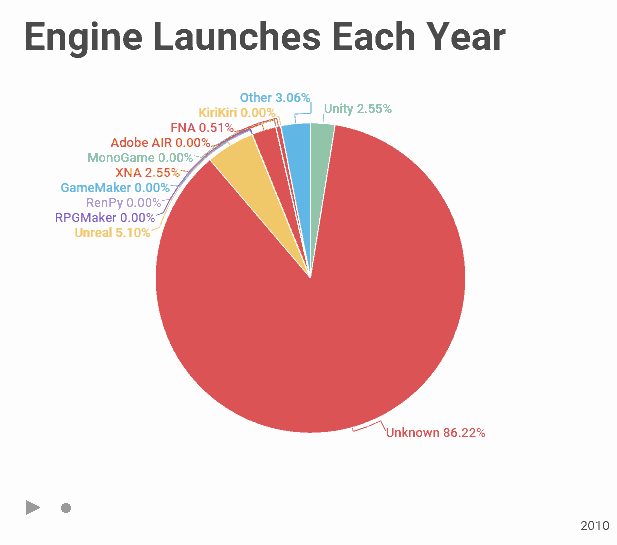Developer Lars Doucet presented a detailed analysis of the most common game engines on Steam. To do this, together with the SteamDB website, he collected a large amount of data about the titles in the Valve store and the tools with which they were made.
Research methodology
In August, Doucet first announced work on the project and shared its source code on GitHub.
At the same time, he clarified that this tool will never work perfectly, but it will still allow you to analyze the engines in Steam fairly accurately.
Doucet published the results of the first study on the Game Developer website (formerly Gamasutra). The data was collected as follows:
- the study took into account only titles released after 2010;
- Doucet and SteamDB scanned all file names in all Steam games for the specified period. They did not have direct access to the data itself, so the analysis was based on similar patterns in the file names inherent in certain engines;
- due to the fact that many game engines do not allow themselves to be detected using this method or give false positive results for other tools, this study cannot be called 100% accurate;
- Doucet and the team still managed to find matches for about two-thirds of all 30 thousand titles on Steam that have at least one review;
- the team did not include unreleased games, free titles, projects cheaper than $4.99 and those games that have less than 50 reviews in the final analysis. This was done in order to exclude amateur titles from the sample and focus only on the premium market.
Based on these criteria, slightly less than 10 thousand games were included in the final sample.
The most popular game engines
Doucet notes that the mass distribution of modern engines began in 2013.
This is clearly visible on the presented interactive graph.
In addition to the main engines, there are two additional categories in the list — “others” (too small engines got here) and “unknown” (they could not be determined using the methods mentioned above).
The number of releases of games on Steam on different engines from 2010 to 2021Unity leads the list by a large margin.
The engine, originally released in 2005 exclusively for Mac, has now become the most common cross-platform tool for creating games. It is especially popular among authors of small and medium-budget projects.
List of other popular engines:
- Unreal Engine — was first used in 1998 in the Epic Games shooter of the same name. Over time, the company has significantly increased its availability, and today authors of games of various genres work on it. Among them are ARK: Survival Evolved, MORDHAU, PUBG, Sea of Thieves, XCOM 2, Borderlands 3 and many others;
- GameMaker Studio is an engine released in 1999 and aimed at novice developers. Mostly 2D games are made on it. Among the titles created on it are Hotline Miami, Katana Zero, Undertale and Risk of Rain;
- Ren’Py is an open source visual novel creation engine. Now it has made over 450 titles on Steam, including Ladykiller in a Bind and Long Live the Queen;
- RPG Maker is an engine for creating mainly RPG, the first version of which was released back in 1992. To The Moon is the most famous game developed with this tool;
- Adobe AIR is an engine released in 2008, which was originally intended to work with flash games and transfer them to Windows or mobile platforms. Among the most popular titles are The Banner Saga, Angry Birds, Samorost 3 and The Henry Stickmin Collection;
- XNA — Microsoft released this engine in 2006 to create games for Windows or Xbox 360. In 2013, it stopped updating, but it still released a number of popular projects. Among them are Borderlands 2, Stardew Valley, Rogue Legacy and Celeste;
- OGRE is an open source engine released in 2006. Until 2014, Roblox worked on it. Also using this tool, the first two parts of Torchlight were developed.
Doucet also mentions the following engines in his research: KiriKiri (visual novels “for adults” are created on it), AdventureGameStudio (used to create point-n-click quests), Source (Valve engine, on which The Stanley Parable, Garry‘s Mod and a number of other projects were also made), Lime/OpenFL (it created indie hits such as Papers, Please and Dicey Dungeons).
Other important dataThe most expensive games are made using the Unreal Engine.
- 25% of titles created on the Epic Games engine are sold at a price of $29.99. For comparison, the share of such games on Unity is only 6%.
- Almost 100% of the titles sold at a price of $49.99 are made either on Unreal or on their own engines. And 85% of the analyzed titles are sold at a price below $19.99.
The cost of games created on different enginesAbout 30% of Steam games are featured on Metacritic.
- The least reviews are written on projects made with the help of RPG Maker. However, this engine leads the average score.
- Today, developers have almost stopped creating their own engines and prefer ready-made solutions. In 2021, less than 20% of games fell into the category of “unknown engines”, which is mainly intended for custom frameworks.
The share of different engines among Steam games released between 2010 and 2021The picture changes dramatically if you look at the list of the highest-grossing Steam games.
- Their developers, on the contrary, use their own engines more often. For example, in the list of “platinum” Steam titles there are only four Unreal Engine projects and only two Unity.
Lars Doucet intends to continue working on a tool for tracking game engines. He has already added it to his GameDataCrunch project, which collects and analyzes data about games on Steam.




